Casio EX-ZS15 User Manual
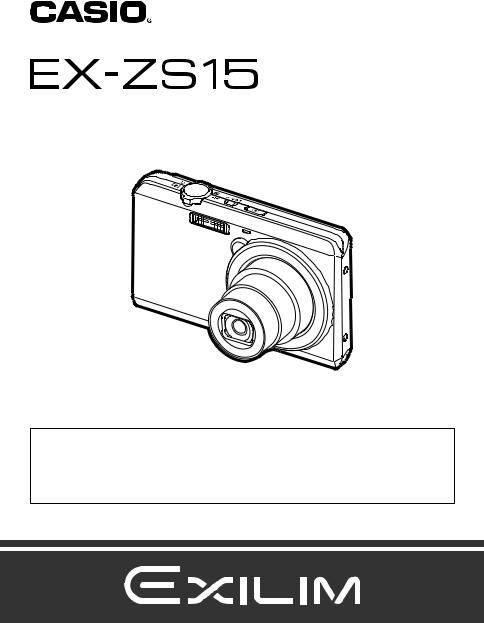
E
Digital Camera
User’s Guide
Thank you for purchasing this CASIO product.
•Before using it, be sure to read the precautions contained in this User’s Guide.
•Keep the User’s Guide in a safe place for future reference.
•For the most up-to-date information about this product, visit the official EXILIM Website at http://www.exilim.com/
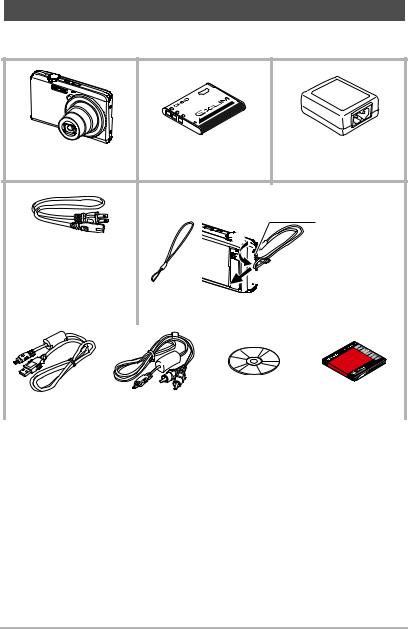
Unpacking
As you unpack your camera, check to make sure that all items shown below are included. If anything is missing, contact your original retailer.
Digital camera |
Rechargeable lithium ion |
USB-AC adaptor |
|
battery (NP-120) |
(AD-C53U) |
||
|
|||
|
To attach the strap to the camera |
||
Attach strap here.
* The shape of the power |
1 |
|
|
cord plug varies |
|
according to country or |
|
geographic area. |
2 |
Power cord |
Strap |
USB cable |
AV cable |
CD-ROM |
Basic Reference |
|
|
|
|
2
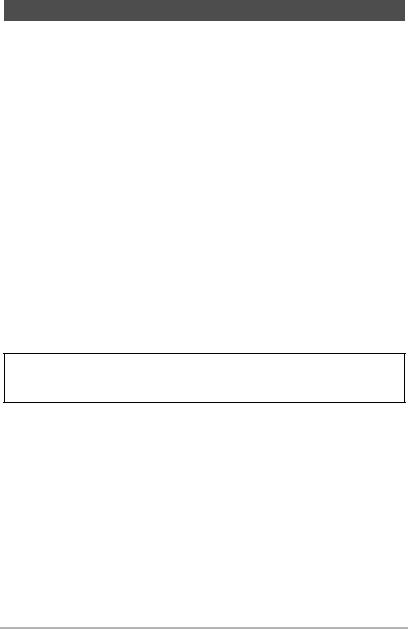
Read this first!
•The contents of this manual are subject to change without notice.
•The contents of this manual have been checked at each step of the production process. Feel free to contact us if you notice anything that is questionable, erroneous, etc.
•Any copying of the contents of this User’s Guide, either in part or its entirety, is forbidden. Except for your own personal use, any other use of the contents of this manual without the permission of CASIO COMPUTER CO., LTD. is forbidden under copyright laws.
•CASIO COMPUTER CO., LTD. shall not be held liable for any damages or lost profits suffered by you or any third party due to the use or malfunction of this product.
•CASIO COMPUTER CO., LTD. shall not be held liable for any damages, lost profits, or claims by third parties arising out of the use of Photo Transport, or YouTube Uploader for CASIO.
•CASIO COMPUTER CO., LTD. shall not be held liable for any damages or lost profits caused by loss of memory contents due to malfunction, repair, or any other reason.
•Note that the example screens and product illustrations shown in this User’s Guide may differ somewhat from the screens and configuration of the actual camera.
LCD Panel
The liquid crystal panel of the monitor screen uses high-precision technology that provides a pixel yield in excess of 99.99%. This means that some very small number of pixels may not light or may remain lit at all times. This is due to the characteristics of the liquid crystal panel, and does not indicate malfunction.
Take test shots
Before shooting your final image, shoot a test shot to ensure that the camera is recording correctly.
3

Contents
Unpacking . . . . . . . . . . . . . . . . . . . . . . . . . . . . . . . . . . . . . . . . . . . . . . . . . . . . 2 Read this first! . . . . . . . . . . . . . . . . . . . . . . . . . . . . . . . . . . . . . . . . . . . . . . . . . 3 General Guide . . . . . . . . . . . . . . . . . . . . . . . . . . . . . . . . . . . . . . . . . . . . . . . . . 8 Monitor Screen Contents . . . . . . . . . . . . . . . . . . . . . . . . . . . . . . . . . . . . . . . . . 9 Selecting Display Information (DISP) . . . . . . . . . . . . . . . . . . . . . . . . . . . . . . 10
Quick Start Basics |
11 |
What is a digital camera? . . . . . . . . . . . . . . . . . . . . . . . . . . . . . . . . . . . . . . . 11 What you can do with your CASIO camera . . . . . . . . . . . . . . . . . . . . . . . . . . 12 Using the Touch Panel. . . . . . . . . . . . . . . . . . . . . . . . . . . . . . . . . . . . . . . . . . 13 First, charge the battery prior to use.. . . . . . . . . . . . . . . . . . . . . . . . . . . . . . . 14
To load the battery . . . . . . . . . . . . . . . . . . . . . . . . . . . . . . . . . . . . . . . . . . . . . . . 14Charge the Battery . . . . . . . . . . . . . . . . . . . . . . . . . . . . . . . . . . . . . . . . . . . . . . . 15
Configuring Basic Settings the First Time You Turn On the Camera. . . . . . . 20 Preparing a Memory Card . . . . . . . . . . . . . . . . . . . . . . . . . . . . . . . . . . . . . . . 21
Supported Memory Cards. . . . . . . . . . . . . . . . . . . . . . . . . . . . . . . . . . . . . . . . . . 21To load a memory card . . . . . . . . . . . . . . . . . . . . . . . . . . . . . . . . . . . . . . . . . . . . 22To format (initialize) a new memory card . . . . . . . . . . . . . . . . . . . . . . . . . . . . . . 23
Turning Power On and Off . . . . . . . . . . . . . . . . . . . . . . . . . . . . . . . . . . . . . . . 24 Holding the Camera Correctly . . . . . . . . . . . . . . . . . . . . . . . . . . . . . . . . . . . . 25 To Shoot a Snapshot . . . . . . . . . . . . . . . . . . . . . . . . . . . . . . . . . . . . . . . . . . . 26
Selecting an Auto Recording Mode . . . . . . . . . . . . . . . . . . . . . . . . . . . . . . . . . . 26To shoot a snapshot . . . . . . . . . . . . . . . . . . . . . . . . . . . . . . . . . . . . . . . . . . . . . . 27
Viewing Snapshots . . . . . . . . . . . . . . . . . . . . . . . . . . . . . . . . . . . . . . . . . . . . 29 Deleting Snapshots and Movies . . . . . . . . . . . . . . . . . . . . . . . . . . . . . . . . . . 30
To delete a single file . . . . . . . . . . . . . . . . . . . . . . . . . . . . . . . . . . . . . . . . . . . . . 30To delete all files . . . . . . . . . . . . . . . . . . . . . . . . . . . . . . . . . . . . . . . . . . . . . . . . . 30
Snapshot Shooting Precautions . . . . . . . . . . . . . . . . . . . . . . . . . . . . . . . . |
. . 31 |
Auto Focus Restrictions . . . . . . . . . . . . . . . . . . . . . . . . . . . . . . . . . . . . . . . . . |
. . 31 |
Recording Images |
32 |
Selecting a Recording Mode . . . . . . . . . . . . . . . . . . . . . . . . . . . . . . . . . . . . . 33 Using Flash . . . . . . . . . . . . . . . . . . . . . . . . . . . . . . . . . . . . . . . . . . .(Flash) . . 33 Shooting with Zoom . . . . . . . . . . . . . . . . . . . . . . . . . . . . . . . . . . . . . . . . . . . . 35
Interpreting the Zoom Bar . . . . . . . . . . . . . . . . . . . . . . . . . . . . . . . . . . . . . . . . . . 36
To record a movie . . . . . . . . . . . . . . . . . . . . . . . . . . . . . . . . . . . . . . . . . . . . . 37
Using BEST SHOT |
39 |
4 |
Contents |
|

Advanced Recording Settings |
|
41 |
Using the REC Menu . . . . . . . . . . . . . . . . . . . . . . . . . . . . |
. . . . . . . . . . . . . |
. . 41 |
Using Touch Shutter . . . . . . . . . . . . . . . . . . . . . . . . . . . . . |
. .(Touch Shutter). |
. . 42 |
Using the Self-timer . . . . . . . . . . . . . . . . . . . . . . . . . . . . . |
. . . . . (Self-timer). |
. . 42 |
Selecting a Focus Mode . . . . . . . . . . . . . . . . . . . . . . . . . . |
. . . . . . . (Focus). |
. . 43 |
Changing the Image Size . . . . . . . . . . . . . . . . . . . . . . . . . . |
. . .(Image Size). |
. . 45 |
Movie Image Quality Settings . . . . . . . . . . . . . . . . . . . . . . |
. (Movie Quality). |
. . 47 |
Using Face Detection . . . . . . . . . . . . . . . . . . . . . . . . . . . . . |
(Face Detection). |
. . 47 |
Correcting Image Brightness . . . . . . . . . . . . . . . . . . . . . . . |
. . . . . (EV Shift). |
. . 48 |
Adjusting White Balance . . . . . . . . . . . . . . . . . . . . . . . . . . |
(White Balance). |
. . 49 |
Specifying ISO Sensitivity . . . . . . . . . . . . . . . . . . . . . . . . . |
. . . . . . . . .(ISO). |
. . 50 |
Optimizing Image Brightness . . . . . . . . . . . . . . . . . . . . . . . |
. . . . . (Lighting). |
. . 50 |
Using Built-in Color Filters . . . . . . . . . . . . . . . . . . . . . . . . . |
. . . (Color Filter). |
. . 51 |
Reducing the Effects of Camera and Subject Movement |
. . . . (Anti Shake). |
. . 51 |
Displaying the On-screen Grid . . . . . . . . . . . . . . . . . . . . . . |
. . . . . . . . (Grid). |
. . 52 |
Configuring Power On Default Settings . . . . . . . . . . . . . . . |
. . . . . (Memory). |
. . 52 |
Viewing Snapshots and Movies |
|
53 |
Viewing Snapshots . . . . . . . . . . . . . . . . . . . . . . . . . . . . . . |
. . . . . . . . . . . . |
. . 53 |
Viewing a Movie. . . . . . . . . . . . . . . . . . . . . . . . . . . . . . . . . |
. . . . . . . . . . . . |
. . 53 |
Playing a Slideshow on the Camera . . . . . . . . . . . . . . . . . |
. . . (Slideshow) |
. . 54 |
Viewing the Image Menu . . . . . . . . . . . . . . . . . . . . . . . . . . |
. . . . . . . . . . . . |
. . 55 |
Zooming an On-screen Image . . . . . . . . . . . . . . . . . . . . . . |
. . . . . . . . . . . . |
. . 55 |
Viewing Snapshots and Movies on a TV Screen. . . . . . . . |
. . . . . . . . . . . . |
. . 56 |
Other Playback Functions |
(PLAY) |
58 |
Using the PLAY Menu . . . . . . . . . . . . . . . . . . . . . . . . . . . . |
. . . . . . . . . . . . |
. . 58 |
Rotating an Image . . . . . . . . . . . . . . . . . . . . . . . . . . . . . . . |
. . . . . (Rotation). |
. . 59 |
Selecting Images for Printing . . . . . . . . . . . . . . . . . . . . . . . |
(DPOF Printing). |
. . 59 |
Protecting a File Against Deletion . . . . . . . . . . . . . . . . . . . |
. . . . . . (Protect). |
. . 59 |
Resizing a Snapshot . . . . . . . . . . . . . . . . . . . . . . . . . . . . . |
. . . . . . (Resize). |
. . 60 |
Cropping a Snapshot . . . . . . . . . . . . . . . . . . . . . . . . . . . . . |
. . . . (Trimming). |
. . 61 |
Copying Files . . . . . . . . . . . . . . . . . . . . . . . . . . . . . . . . . . . |
. . . . . . . (Copy). |
. . 62 |
Printing |
|
63 |
Printing Snapshots. . . . . . . . . . . . . . . . . . . . . . . . . . . . . . . |
. . . . . . . . . . . . |
. . 63 |
Using DPOF to Specify Images to be Printed and the Number of Copies. . . 63 |
||
5 |
Contents |
|

Using the Camera with a Computer |
66 |
Things you can do using a computer... . . . . . . . . . . . . . . . . . . . . . . . . . . . . . 66 Using the Camera with a Windows Computer . . . . . . . . . . . . . . . . . . . . . . . . 67
Viewing and Storing Images on a Computer. . . . . . . . . . . . . . . . . . . . . . . . . . . . 68Playing Movies . . . . . . . . . . . . . . . . . . . . . . . . . . . . . . . . . . . . . . . . . . . . . . . . . . 71Uploading Movie Files to YouTube . . . . . . . . . . . . . . . . . . . . . . . . . . . . . . . . . . . 72Transferring Images from Your Computer to Camera Memory. . . . . . . . . . . . . . 73User Registration . . . . . . . . . . . . . . . . . . . . . . . . . . . . . . . . . . . . . . . . . . . . . . . . 75
Using the Camera with a Macintosh . . . . . . . . . . . . . . . . . . . . . . . . . . . . . . . 75
Connecting the Camera to Your Computer and Saving Files . . . . . . . . . . . . . . . 75Transferring Images Automatically and Managing Them on Your Macintosh. . . 77Playing a Movie. . . . . . . . . . . . . . . . . . . . . . . . . . . . . . . . . . . . . . . . . . . . . . . . . . 78User Registration . . . . . . . . . . . . . . . . . . . . . . . . . . . . . . . . . . . . . . . . . . . . . . . . 78
Using an Eye-Fi Wireless SD Memory Card to Transfer Images . (Eye-Fi) . . 79 Files and Folders . . . . . . . . . . . . . . . . . . . . . . . . . . . . . . . . . . . . . . . . . . . . . . 80 Memory Card Data . . . . . . . . . . . . . . . . . . . . . . . . . . . . . . . . . . . . . . . . . . . . 81
Other Settings |
(Set Up) 83 |
Turning off Eye-Fi Card Communication . . . . . . . . . . . . . . . . . . . . (Eye-Fi) . . 83 Configuring Camera Sound Settings . . . . . . . . . . . . . . . . . . . . . (Sounds) . . 83 Turning the Startup Movie On or Off . . . . . . . . . . . . . . . . . . . . . . (Startup) . . 84 Specifying the File Name Serial Number Generation Rule . . . . . (File No.) . . 84 Configuring World Time Settings . . . . . . . . . . . . . . . . . . . . . (World Time) . . 85
Setting a Travel Destination . . . . . . . . . . . . . . . . . . . . . . . . . . . . . . . . . . . . . . . . 85Selecting the Time Display . . . . . . . . . . . . . . . . . . . . . . . . . . . . . . . . . . . . . . . . . 86
Time Stamping Snapshots . . . . . . . . . . . . . . . . . . . . . . . . . . (Timestamp) . . 86 Setting the Camera’s Clock . . . . . . . . . . . . . . . . . . . . . . . . . . . . . (Adjust) . . 87 Specifying the Date Style . . . . . . . . . . . . . . . . . . . . . . . . . . . . (Date Style) . . 87 Specifying the Display Language . . . . . . . . . . . . . . . . . . . . . . (Language) . . 88 Calibrating the Touch Panel . . . . . . . . . . . . . . . . . . . . . . . . (Calibrate TP) . . 88 Configuring Sleep State Settings . . . . . . . . . . . . . . . . . . . . . . . . . (Sleep) . . 89 Configuring Auto Power Settings . . . . . . . . . . . . . . . . . . (Auto Power Off) . . 89 Selecting the Screen Aspect Ratio and Video Output System (Video Out) . . 90 Formatting Built-in Memory or a Memory Card . . . . . . . . . . . . . . (Format) . . 90 Resetting the Camera to Factory Defaults . . . . . . . . . . . . . . . . . . (Reset) . . 91
6 |
Contents |
|

Appendix |
92 |
Precautions during Use . . . . . . . . . . . . . . . . . . . . . . . . . . . . . . . . . . . . . . . . . 92 Power Supply. . . . . . . . . . . . . . . . . . . . . . . . . . . . . . . . . . . . . . . . . . . . . . . . . 99
Charging . . . . . . . . . . . . . . . . . . . . . . . . . . . . . . . . . . . . . . . . . . . . . . . . . . . . . . . 99To replace the battery . . . . . . . . . . . . . . . . . . . . . . . . . . . . . . . . . . . . . . . . . . . . 100Battery Precautions. . . . . . . . . . . . . . . . . . . . . . . . . . . . . . . . . . . . . . . . . . . . . . 100Using the Camera in another Country . . . . . . . . . . . . . . . . . . . . . . . . . . . . . . . 101
Using a Memory Card . . . . . . . . . . . . . . . . . . . . . . . . . . . . . . . . . . . . . . . . . 101
To replace the memory card . . . . . . . . . . . . . . . . . . . . . . . . . . . . . . . . . . . . . . . 101
Computer System Requirements for Bundled Software (For Windows) . . . 103 Reset Initial Default Settings . . . . . . . . . . . . . . . . . . . . . . . . . . . . . . . . . . . . 104 When things don’t go right... . . . . . . . . . . . . . . . . . . . . . . . . . . . . . . . . . . . . 106
Troubleshooting . . . . . . . . . . . . . . . . . . . . . . . . . . . . . . . . . . . . . . . . . . . . . . . . 106Display Messages. . . . . . . . . . . . . . . . . . . . . . . . . . . . . . . . . . . . . . . . . . . . . . . .111
Number of Snapshots/Movie Recording Time . . . . . . . . . . . . . . . . . . . . . . . 113 Specifications. . . . . . . . . . . . . . . . . . . . . . . . . . . . . . . . . . . . . . . . . . . . . . . . 114
7 |
Contents |
|
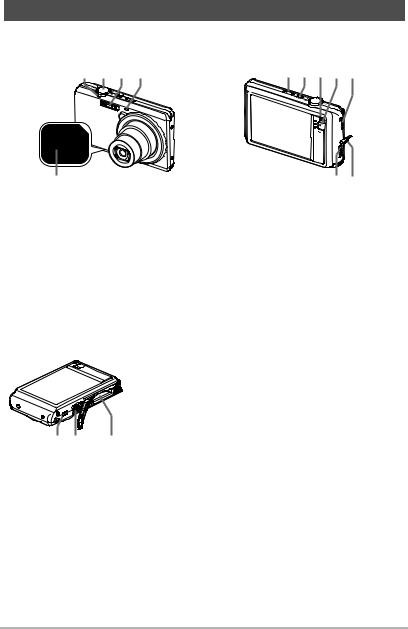
General Guide
The numbers in parentheses indicate the pages where each item is explained.
Front |
Back |
1 2 3 4 |
7 8 9 bk bl |
|
|
|
|
|
|
|
|
|
|
|
|
|
|
|
|
|
|
|
|
|
6 |
|
|
|
|
|
|
5 |
|
bo |
bn bm |
|||
1Zoom controller |
|
|
7[p] (PLAY) button |
blStrap hole (page 2) |
||
(pages 27, 35, 55, 55) |
(pages 24, 29) |
bmConnector cover |
||||
2Shutter button (page 27) |
8[ON/OFF] (Power) |
bn[USB/AV] port |
||||
3Flash (page 33) |
|
|
(pages 15, 20, 24) |
|
|
(pages 16, 17, 56, 68, |
4Front lamp |
|
|
9Back lamp |
|
|
76) |
(pages 25, 42) |
|
|
(pages 16, 18, 24, 27, |
boMonitor screen |
||
5Lens |
|
|
34) |
|
|
(pages 9, 10) |
6Microphone (page 38) |
bk[0] (Movie) button |
|
|
|
||
|
|
|
(pages 28, 37) |
|
|
|
Bottom
bpBattery/memory card slots (pages 14, 22, 100, 101) bqTripod hole
Use this hole when attaching to a tripod. brSpeaker
br bq |
bp |
8

Monitor Screen Contents
The monitor screen uses various indicators, icons, and values to keep you informed of the camera’s status.
•The sample screens in this section are intended to show you the locations of all the indicators and figures that can appear on the monitor screen in various modes. They do not represent screens that actually appear on the camera.
. Snapshot Recording
1 2 3 4 5 6 7 8
bp
bo |
9 |
|
|
||
bn |
|
|
bm |
bk |
|
bl |
||
|
1Tab (page 24)
2Focus mode (page 43)
3Self-timer mode (page 42)
4Flash (page 33)
5Snapshot image size (page 45)
6Movie quality (pages 37, 47)
7Digital zoom (page 36)
8Remaining snapshot memory capacity (page 113)
9Remaining movie memory capacity (pages 37, 113)
bkBattery level indicator (page 19) blPLAY mode icon (page 24) bmInformation icon (page 10) bnFlash icon (page 33)
boRecording mode icon (pages 26, 33) bpMenu icon (page 41)
. Movie Recording
1 2 3 4
1Movie quality (pages 37, 47)
2Recording time switch icon (page 37)
3Movie remaining time icon (page 37)  5 4Remaining movie memory capacity/ Movie recording time (pages 37, 113)
5 4Remaining movie memory capacity/ Movie recording time (pages 37, 113)
5Digital zoom (page 36)
. Snapshot Viewing
1 2 3 4
bl bk 9 8 7
6 5
1Tab (page 24)
2Protect indicator (page 59)
3Folder name/file name (page 80)
4Snapshot image size (page 45)
5Battery level indicator (page 19)
6Date/time (pages 20, 87)
7REC mode icon (page 24)
8Information icon (page 10)
9Delete icon (page 30) bkSlideshow icon (page 54) blMenu icon (page 58)
B |
9 |
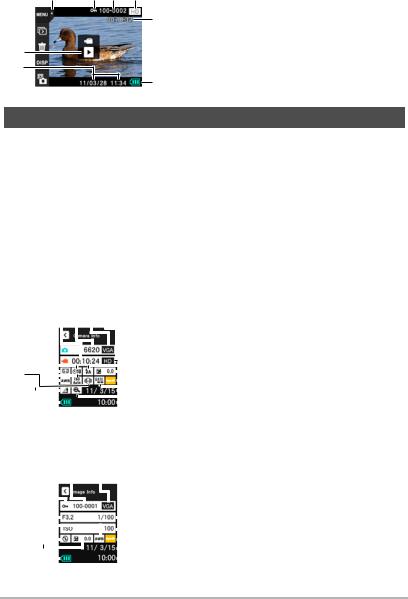
. Movie Playback
1 2 3 4
5
8
7
6
1Tab (page 24)
2Protect indicator (page 59)
3Folder name/file name (page 80)
4Movie quality (pages 37, 47)
5Movie recording time (page 53)
6Battery level indicator (page 19)
7Date/time (pages 20, 87)
8“6” Movie play icon (page 53)
Selecting Display Information (DISP)
Each touch of “DISP” will cycle through settings that display or hide on-screen information. You can configure separate settings for the REC mode and PLAY mode.
•If “DISP” is not displayed on the screen, touch the tab to display it.
•Display information cannot be changed during movie recording.
Off |
No information displayed. |
Information On |
Shows information about image settings, etc. |
|
Shows more detailed information about settings. |
Status On |
• When Status On is selected, you will not be able to view |
|
the subject on the monitor screen. |
. Info Screens
REC Mode Info Screen
bs |
|
12345 |
|
|
|
1Remaining movie |
9Date |
||||||||||||||||||
|
|
|
|
|
|
|
|
|
|
|
|
|
|
|
|
|
|
|
|
|
|
|
memory capacity |
bkDigital zoom |
|
br |
|
|
|
|
|
|
|
|
|
|
|
|
|
|
|
|
|
|
|
|
|
|
6 |
||
|
|
|
|
|
|
|
|
|
|
|
|
|
|
|
|
|
|
|
|
|
2Remaining snapshot |
blTime |
|||
bq |
|
|
|
|
|
|
|
|
|
|
|
|
|
|
|
|
|
|
|
|
|
7 |
memory capacity |
bmBattery level indicator |
|
|
|
|
|
|
|
|
|
|
|
|
|
|
|
|
|
|
|
|
|
||||||
bp |
|
|
|
|
|
|
|
|
|
|
|
|
|
|
|
|
|
|
|
|
|
8 |
3Snapshot image size |
bnLighting setting |
|
|
|
|
|
|
|
|
|
|
|
|
|
|
|
|
|
|
|
|
|
|
|||||
bo |
|
|
|
|
|
|
|
|
|
|
|
|
|
|
|
|
|
|
|
|
9 |
4Movie quality |
boAnti Shake |
||
|
|
|
|
|
|
|
|
|
|
|
|
|
|
|
|
|
|
|
|
5Flash |
bpWhite balance setting |
||||
|
|
|
|
|
|
|
|
|
|
|
|
|
|
|
|
|
|
|
|
||||||
bn |
|
|
|
|
|
|
|
|
|
|
|
|
|
|
|
|
|
|
|
|
|
bk |
|||
|
|
|
|
|
|
|
|
|
|
|
|
|
|
|
|
|
|
|
|
|
6Exposure |
bqISO sensitivity |
|||
|
|
|
|
|
|
|
|
|
|
|
|
|
|
|
|
|
|
|
|||||||
bm |
|
|
|
|
|
|
|
|
|
|
|
|
|
|
|
|
|
|
|
|
|
bl |
compensation |
brFace Detection/ |
|
|
|
|
|
|
|
|
|
|
|
|
|
|
|
|
|
|
|
|
|
|
|||||
|
|
|
|
|
|
|
|
|
|
|
|
|
|
|
|
|
|
|
|
|
|
|
|
7Eye-Fi setting |
Focus mode |
|
|
|
|
|
|
|
|
|
|
|
|
|
|
|
|
|
|
|
|
|
|
|
|
8Timestamp indicator |
bsSelf-timer mode |
PLAY Mode Info Screen |
|
|
|
1Protect indicator |
8Time |
||||||||||||||||||||
|
|
1 2 3 4 |
|
|
|
||||||||||||||||||||
|
|
|
|
|
|
|
|
|
|
|
|
|
|
|
|
|
|
|
|
|
|
|
5 |
2Folder name/ |
9Battery level indicator |
|
|
|
|
|
|
|
|
|
|
|
|
|
|
|
|
|
|
|
|
|
|
file name |
bkExposure |
||
bn |
|
|
|
|
|
|
|
|
|
|
|
|
|
|
|
|
|
|
|
|
|
6 |
3Snapshot image size |
compensation |
|
bm |
|
|
|
|
|
|
|
|
|
|
|
|
|
|
|
|
|
|
|
|
|
|
|
4Shutter speed |
blFlash |
bl |
|
|
|
|
|
|
|
|
|
|
|
|
|
|
|
|
|
|
|
|
|
7 |
5ISO sensitivity |
bmWhite balance setting |
|
bk |
|
|
|
|
|
|
|
|
|
|
|
|
|
|
|
|
|
|
|
|
|
|
|
6Eye-Fi setting |
bnAperture value |
|
|
|
|
|
|
|
|
|
|
|
|
|
|
|
|
|
|
|
|
|
|
|
|||
|
|
|
|
|
|
|
|
|
|
|
|
|
|
|
|
|
|
|
|
|
8 |
7Date |
|
||
9 |
|
|
|
|
|
|
|
|
|
|
|
|
|
|
|
|
|
|
|
|
|
|
|
||
|
|
|
|
|
|
|
|
|
|
|
|
|
|
|
|
|
|
|
|
|
|
|
|||
B |
10 |

Quick Start Basics
What is a digital camera?
A digital camera stores images on a memory card, so you can record and delete images a countless number of times.
Delete |
Record
Play |
You can use the images you record in a variety of different ways.
Store images on your |
Print images. |
Attach images to e-mail. |
computer. |
|
|
11 |
Quick Start Basics |
|
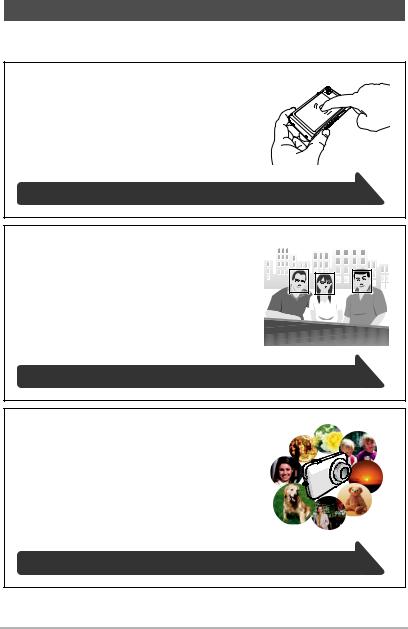
What you can do with your CASIO camera
Your CASIO camera is packed with a powerful selection of features and functions to make recording of digital images easier, including the following three main functions.
Simple touch panel operation
The monitor screen is a touch panel that can be used to perform operations.
See page 13 for more information.
Face Detection
Point the camera at a person and it automatically detects the person’s face for beautiful portraits every time.
See page 47 for more information.
BEST SHOT
Simply select the sample scene you want and the camera sets up automatically. Then all you need to do is press the shutter button for perfect images.
See page 39 for more information.
12 |
Quick Start Basics |
|
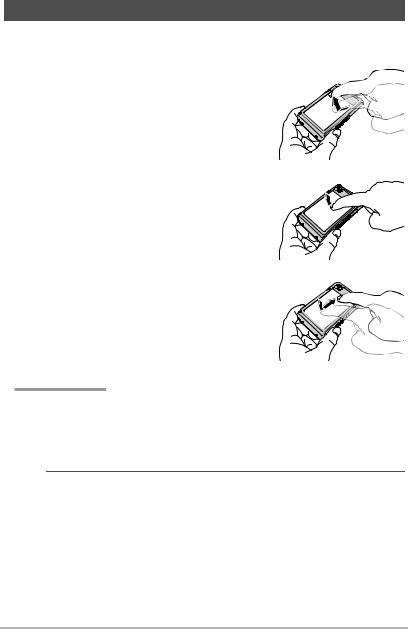
Using the Touch Panel
The monitor screen of the camera is a touch panel. This means you can perform the following operations by touching the screen with your fingers.
Touch
Momentarily touching the screen with your finger. Touch the screen to select an icon or menu item, and to configure settings.
Touch-and-hold
Holding your finger against the screen.
Touch and hold the screen to scroll images at high speed, or to perform continual frame-by-frame playback of a movie.
Drag
Holding your finger against the screen as you drag it up, down, left, or right.
Use drag to move a screen image to a different location, and to scroll between images.
 IMPORTANT!
IMPORTANT!
•Never use a pointed or hard object to perform screen operations. Doing so can damage the screen.
•The touch panel is pressure-sensitive. Make sure you touch the panel with sufficient pressure when operating it.
 NOTE
NOTE
•Applying a commercially available LCD protective sheet will reduce the operation sensitivity of the monitor screen.
•If touch panel item selections are not performed as expected, calibrate the touch panel (page 88).
13 |
Quick Start Basics |
|
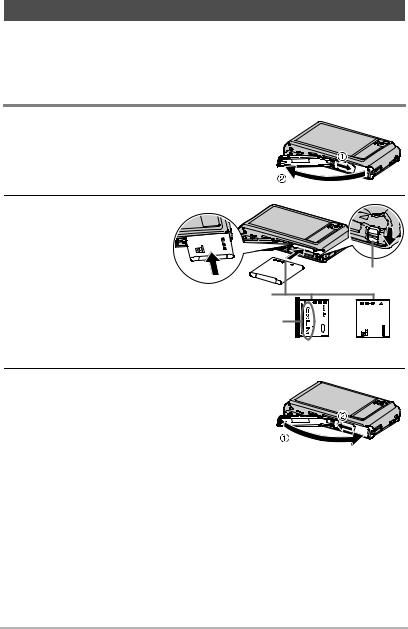
First, charge the battery prior to use.
Note that the battery of a newly purchased camera is not charged. Perform the steps below to load the battery into the camera and charge it.
•Your camera requires a special CASIO rechargeable lithium ion battery (NP-120) for power. Never try to use any other type of battery.

 To load the battery
To load the battery
1.Open the battery cover.
Pressing the battery cover, slide it in the direction indicated by the arrow.
2.Load the battery.
With the EXILIM logo on the battery facing downwards (in the direction of the lens), hold the stopper next to the battery in the direction indicated by the arrow as you slide the battery into the camera. Press the battery in until the stopper secures it in place.
Stopper
Battery contacts
EXILIM logo
Front Back
3.Close the battery cover.
Pressing the battery cover against the camera, slide it closed.
•For information about how to replace the battery, see page 100.
14 |
Quick Start Basics |
|
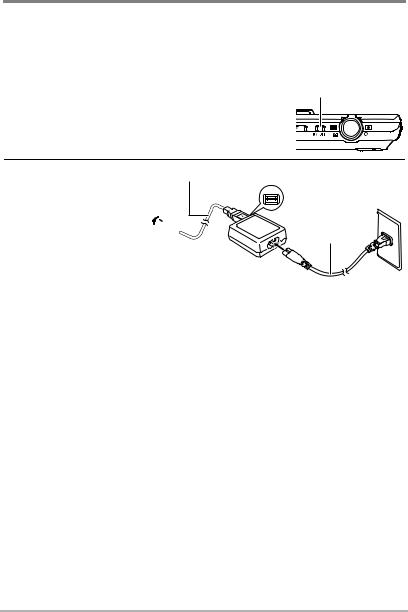

 Charge the Battery
Charge the Battery
You can use either of the two following methods to charge the camera’s battery.
•USB-AC adaptor
•USB connection to a computer
. To charge with the USB-AC adaptor
1. Turn off the camera. [ON/OFF] (Power)
Check to make sure that the camera’s monitor screen is blank. If it isn’t, press [ON/OFF] (Power) to turn off the camera.
2.After connecting the supplied USB cable to the USB-AC adaptor, plug the power cord into a household power outlet.
USB cable (included with camera)
USB
USB port

 Power cord USB-AC adaptor
Power cord USB-AC adaptor 


15 |
Quick Start Basics |
|
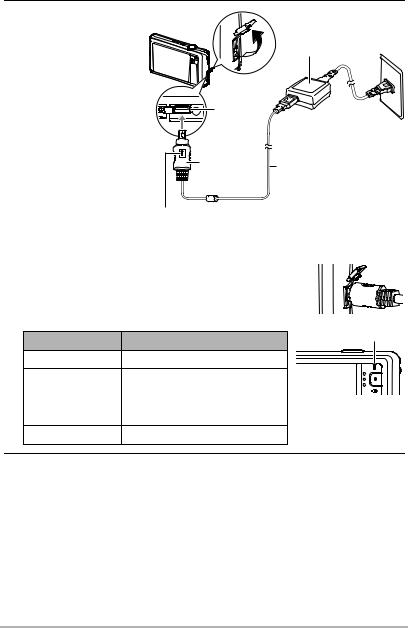
3.Connect the USB cable to the camera.
The back lamp should light red, indicating that charging has started.
The back lamp will go out when charging is complete.
It takes about
110 minutes to bring a fully dead battery to a full charge.
|
USB-AC adaptor |
|
[USB/AV] |
|
|
port |
|
|
Small |
USB cable |
|
connector |
||
(included with camera) |
||
|
Making sure that the  mark on the USB cable connector is towards the lens side, connect the cable to the camera.
mark on the USB cable connector is towards the lens side, connect the cable to the camera.
•Note that even while the connector is fully inserted, you still will be able to see the metal part of the connector as
shown in the illustration.
Back Lamp Operation
Lamp Status |
Description |
Back lamp |
|
||
Lit Red |
Charging |
|
|
Abnormal ambient temperature, |
|
Flashing Red |
USB-AC adaptor problem, |
|
battery problem, or charging |
|
|
|
|
|
|
terminated by timer (page 99) |
|
Off |
Charging complete |
|
4.After charging is complete, disconnect the USB cable from the camera and then unplug the power cord from the power outlet.
16 |
Quick Start Basics |
|
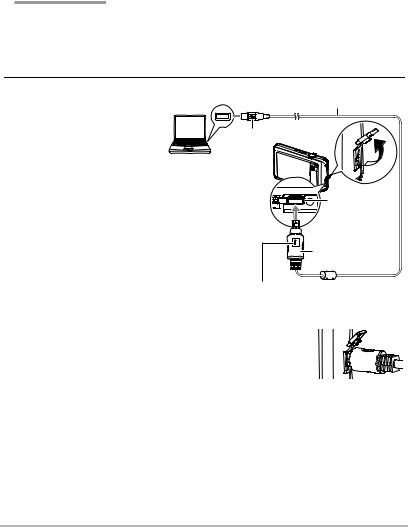
. To charge using a USB connection to a computer
The battery loaded in the camera is charged whenever the camera is connected directly to a computer with the USB cable.
•Depending on the setup of your computer, you may not be able to charge the camera’s battery over a USB connection. If this happens, use of the USB-AC adaptor that comes with the camera is recommended.
 IMPORTANT!
IMPORTANT!
•The first time you connect the camera to your computer with the USB cable, an error message may appear on your computer. If this happens, disconnect and then reconnect the USB cable.
1. Press [ON/OFF] (Power) to turn off the camera.
2.With your computer turned on, connect the camera to it.
The back lamp should light red, indicating that charging has started.
The back lamp will go out when charging is complete. It takes about 130 minutes to achieve a full charge. Charging may take longer depending on charging conditions.
USB port |
USB cable |
|
(included with camera) |
||
|
||
Large connector |
||
|
[USB/AV] port |
|
|
Small connector |
|
Making sure that the  mark on the USB cable connector is towards the lens side, connect the cable to the camera.
mark on the USB cable connector is towards the lens side, connect the cable to the camera.
•Note that even while the connector is fully inserted, you still will be able to see the metal part of the connector as shown in the illustration.
17 |
Quick Start Basics |
|

Back Lamp Operation
Lamp Status |
Description |
Back lamp |
|
||
Lit Red |
Charging |
|
|
Abnormal ambient temperature, |
|
Flashing Red |
charging taking abnormally long, |
|
|
or battery problem (page 99) |
|
Off |
Charging complete |
|
3.After charging is complete, disconnect the USB cable from the camera and then from the computer.
 NOTE
NOTE
•Charging continues while a camera is connected to a computer’s USB port, even if the camera is turned off. Under this condition, the back lamp operates as described under “Back Lamp Operation” (page 16).
 IMPORTANT!
IMPORTANT!
•Charging is not performed while the connected computer is in the hibernate mode.
•A charging error can occur immediately after charging begins or some time after charging begins. A charging error is indicated by the back lamp flashing red.
•If low supply capacity exists due to your computer model or connection conditions, charging will start without the camera turning on. Turning on the camera in this case will cause charging to stop and enter USB data communication between the camera and the computer. The camera’s back lamp will be lit green at this time.
18 |
Quick Start Basics |
|
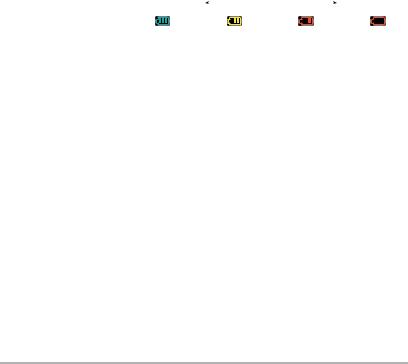
Other Charging Precautions
•With the two charging methods described above, you can charge the camera’s battery (NP-120) without removing it from the camera. You also can charge the battery using an optionally available charger unit (BC-120L). Never use any other type of charger device. Attempting to use a different charger can result in unexpected accident.
•A battery that is still warm immediately after normal use may not charge fully. Give the battery time to cool before charging it.
•A battery discharges slightly even when it is not loaded in the camera. Because of this, it is recommended that you charge the battery immediately before you need to use it.
•Charging the camera’s battery may cause interference with TV and radio reception. If this happens, plug the USB-AC adaptor into an outlet that is further away from the TV or radio.
•Actual charging time depends on current battery capacity and charging conditions.
•Do not use the USB-AC adaptor with any other device.
Checking Remaining Battery Power
As battery power is consumed, a battery indicator on the monitor screen indicates remaining power as shown below.
Remaining Power |
|
|
High |
|
|
|
|
|
|
Low |
||
|
|
|
|
|
|
|||||||
Battery Indicator |
|
|
* |
|
|
* |
|
|
* |
|
|
|
|
|
|
|
|||||||||
|
|
|
|
|
|
|
|
|
|
|
|
|
Indicator Color |
Cyan * Yellow |
* Red |
* Red |
|||||||||
|
|
|
|
|
|
|
|
|
|
|
|
|
 indicates battery power is low. Charge the battery as soon as possible. Recording is not possible when
indicates battery power is low. Charge the battery as soon as possible. Recording is not possible when  is indicated. Charge the battery immediately.
is indicated. Charge the battery immediately.
•The level shown by the battery indicator may change when you switch between the REC mode and PLAY mode.
•Leaving the camera for about 30 days with no power supplied while the battery is dead will cause its date and time settings to be cleared. A message telling you to configure time and date settings will appear the next time you turn on the camera after restoring power. When this happens, configure date and time settings (page 87).
•See page 116 for information about battery life and number of shots.
Battery Power Conservation Tips
•When you do not need to use the flash, select ? (Flash Off) for the flash setting (page 33).
•Enable the Auto Power Off and the Sleep features to protect against wasting battery power when you forget to turn off the camera (pages 89, 89).
19 |
Quick Start Basics |
|

Configuring Basic Settings the First Time You Turn On the
Camera
The first time you turn on the camera, a screen appears for configuring the display language, date, and time settings. Failure to set the date and time correctly will cause the wrong date and time data to be recorded with images.
 IMPORTANT!
IMPORTANT!
•A screen for language selection will not appear in step 2 of the procedure below if you purchased a camera intended for the Japanese market. To change the display language from Japanese in this case, use the procedure under “Specifying the Display Language (Language)” (page 88). Note that a version of this manual in the language you select may not be included with a camera intended for the Japanese market.
•Camera models sold in certain geographic areas may not support display language selection.
1. |
Press [ON/OFF] (Power) to turn on the |
[ON/OFF] (Power) |
|
camera. |
|
2. |
Drag (page 13) upwards and downwards |
|
|
until you find the language you want, and |
|
|
then touch to select it. |
|
3.Touch the date display format you want.
Example: July 10, 2012 YY/MM/DD * 12/7/10 DD/MM/YY * 10/7/12 MM/DD/YY * 7/10/12
4.Touch the value you want to change (year, month, day, hour, minute).
5. Touch “8” or “2” to change the currently selected value.
•Touching and holding “8” or “2” will change the setting at high speed.
• To switch between 12-hour and 24-hour format, |
12/24 hour switch icon |
touch the 12/24 hour switch icon. |
|
20 |
Quick Start Basics |
|
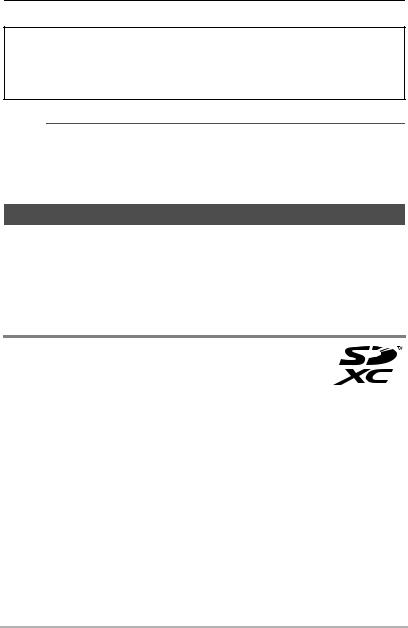
6. When the date and time settings are the way you want, touch “OK”.
If you make a mistake configuring display language, date, or time settings with the above procedure, refer to the following pages for information about how to correct the settings.
–Display language: Page 88
–Date and time: Page 87
 NOTE
NOTE
•Each country controls its local time offset and the use of summer time, and so they are subject to change.
•Removing the battery from the camera too soon after configuring time and date settings for the first time can cause the settings to be reset to their factory defaults. Do not remove the battery for at least 24 hours after configuring settings.
Preparing a Memory Card
Though the camera has built-in memory that can be used to store images and movies, you probably will want to purchase a commercially available memory card for greater capacity. The camera does not come with a memory card. Images recorded while a memory card is loaded are saved to the memory card. When no memory card is loaded, images are saved to built-in memory.
• For information about memory card capacities, see page 113.

 Supported Memory Cards
Supported Memory Cards
– SD Memory Card (Up to 2GB)
– SDHC Memory Card (2GB to 32GB)
– SDXC Memory Card (32GB to 2TB) Use one of the above types of memory card.
•The above are supported memory card types as of June 2011.
•Noted memory card capacities are standard values.
•Use only SD cards that are compliant with the SD Card Association specification.
•This camera supports use of Eye-Fi cards.
21 |
Quick Start Basics |
|
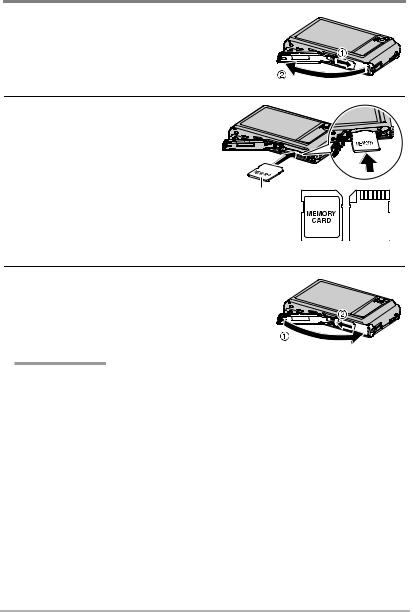

 To load a memory card
To load a memory card
1.Press [ON/OFF] (Power) to turn off the camera and then open the battery cover.
Pressing the battery cover, slide it in the direction indicated by the arrow.
2. Load a memory card.
Positioning the memory card so its front is facing upwards (towards the monitor screen side of the camera), slide it into the card slot all the way in until you hear it click securely into place.
Front
Front Back
3.Close the battery cover.
Pressing the battery cover against the
camera, slide it closed.
• For information about how to replace the memory card, see page 101.
 IMPORTANT!
IMPORTANT!
•Never insert anything besides a supported memory card (page 21) into the memory card slot.
•Should water or any foreign object ever get into the card slot, immediately turn off the camera, remove the battery, and contact your retailer or nearest CASIO authorized service center.
22 |
Quick Start Basics |
|


 To format (initialize) a new memory card
To format (initialize) a new memory card
You need to format a new memory card before using it for the first time.
1.Load a memory card (page 22).
2.Turn on the camera and then touch “MENU”.
•If “MENU” is not displayed on the screen, touch the tab to display it (page 32).
3.Drag (page 13) upwards and downwards until you find “Setup”, and then touch it.
4.Drag upwards and downwards until you find “Format”, and then touch it.
5.Touch “Format” and then touch “Yes”.
This starts the memory card format operation.
 IMPORTANT!
IMPORTANT!
•Formatting a memory card that already has snapshots or other files on it, will delete its contents. Normally you do not need to format a memory card again. However, if storing to a card has slowed down or if you notice any other abnormality, re-format the card.
•Be sure to use the camera to format a memory card. Formatting a memory card on a computer and then using it in the camera can slow down data processing by the camera. In the case of an SD, SDHC, or SDXC memory card, formatting on a computer can result in non-conformity with the SD format, causing problems with compatibility, operation, etc.
•Before formatting a new Eye-Fi card to use it for the first time, copy the Eye-Fi Manager install files to your computer. Do this before formatting the card.
•Before formatting an Eye-Fi card, be sure to back up any data on it that you want to keep.
23 |
Quick Start Basics |
|
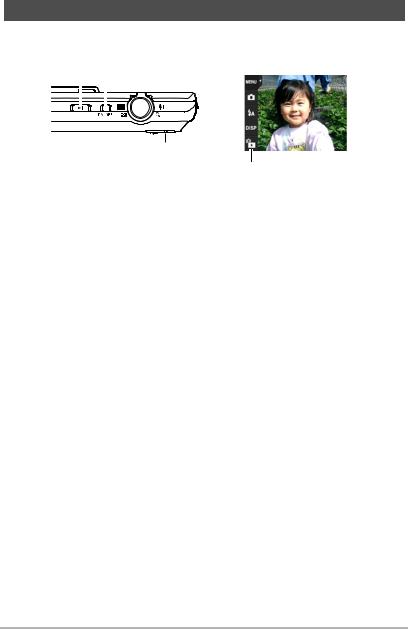
Turning Power On and Off
. To turn on the camera
[p] (PLAY) |
Tab |
|||
|
[ON/OFF] (Power) |
|
|
|
|
|
|
||
|
|
|
|
|
|
|
|
|
|
Back lamp
“f” (PLAY) / “g” (REC)
To turn on power |
Press [ON/OFF] (Power). |
|
and enter the REC |
• The back lamp will light green momentarily and the lens will |
|
mode |
extend out of the camera (page 27). |
|
To turn on power |
Press [p] (PLAY). |
|
• The back lamp will light green momentarily and an image |
||
and enter the |
||
currently stored in camera memory will appear on the monitor |
||
PLAY mode |
||
screen (page 29). |
||
|
||
|
|
•Take care to ensure that nothing is restricting or coming into contact with the lens as it extends. Holding the lens with your hand so it cannot extend creates the risk of malfunction.
•The Sleep function or Auto Power Off (pages 89, 89) will turn off power automatically if you do not perform any operation for a preset amount of time.
Entering the REC Mode and PLAY Mode
To enter the |
In the REC mode, press [p] (PLAY), or touch the tab and |
PLAY mode |
then touch the “f” (PLAY) icon that appears. |
To enter the REC |
In the PLAY mode, press [p] (PLAY), or touch the tab and |
mode |
then touch the “g” (REC) icon that appears. |
•About 10 seconds after you enter the PLAY mode from the REC mode, the lens will retract into the camera.
. To turn off the camera
Press [ON/OFF] (Power).
24 |
Quick Start Basics |
|
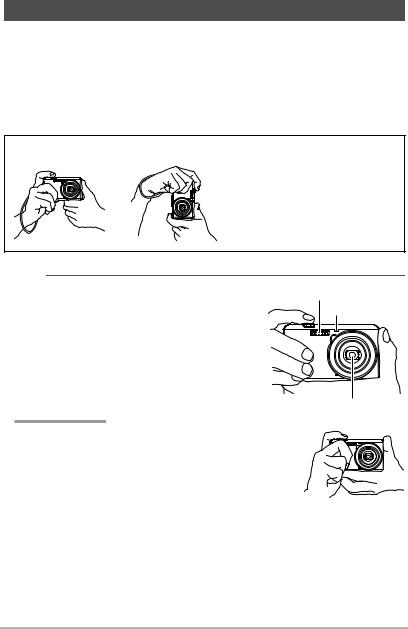
Holding the Camera Correctly
Your images will not come out clearly if you move the camera when you press the shutter button. When pressing the shutter button, be sure to hold the camera as shown in the illustration below, and keep it still by pressing your arms firmly against your sides as you shoot.
Holding the camera still, carefully press the shutter button and take care to avoid all movement as the shutter releases and for a few moments after it releases. This is especially important when available lighting is low, which slows down the shutter speed.
Horizontal Vertical
Hold the camera so the flash is above the lens.
 NOTE
NOTE
•Take care that your fingers and the strap do not cover any of the areas indicated in the illustration.
•To protect against accidentally dropping the camera, attach the wrist strap and make sure it is around your fingers or wrist while you are operating the camera.
•Never swing the camera around by its strap.
•The supplied strap is intended for use with this camera only. Never use it for any other purpose.
 IMPORTANT!
IMPORTANT!
•Take care to ensure that your fingers are not blocking or are not too close to the flash. Fingers can cause unwanted shadows when using the flash.
Flash
Front lamp
Lens
25 |
Quick Start Basics |
|

To Shoot a Snapshot
Your camera has a variety of different recording modes to suit various shooting conditions and objectives (page 33). This section explains general shooting procedures using the auto recording mode.

 Selecting an Auto Recording Mode
Selecting an Auto Recording Mode
You can select one of two recording modes (Auto or BEST SHOT) according to your digital imaging needs.
|
R |
Auto |
This is the standard Auto recording mode. |
|
|
|
|
|
|
|
|
|
|
With BEST SHOT, simply select the sample scene that |
|
|
BEST SHOT |
resembles the type of shot you want, and the camera |
|
|
b |
|||
|
automatically configures ideal settings for the subject and |
|||
|
|
|
|
|
|
|
|
|
shooting conditions (page 39). |
|
|
|
|
|
1.Press [ON/OFF] (Power) to turn on the camera.
2.Touch the second icon from the top (Recording mode).
If the icon is not displayed on the screen, touch the tab to display it.
Recording mode icon
3.Touch “Auto” to select the auto recording mode.
26 |
Quick Start Basics |
|
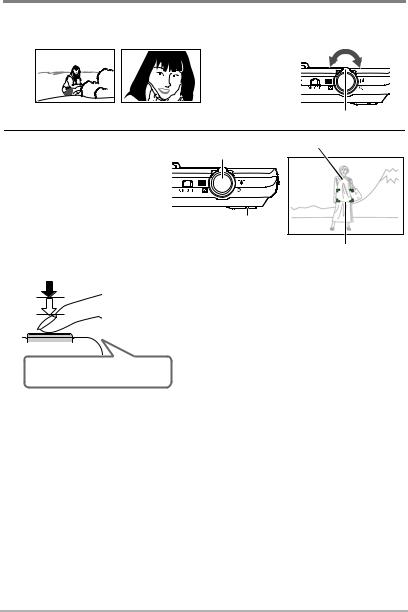

 To shoot a snapshot
To shoot a snapshot
1.Point the camera at the subject.
•You can zoom the image, if you want.
w Wide Angle |
z Telephoto |
Zoom controller |
|
|
2. Half-press the shutter |
Subject to be focused on |
button to focus the |
Shutter button |
|
|
image. |
|
When focus is complete, |
|
the camera will beep, the |
|
back lamp will light green, |
|
and the focus frame will turn |
Back lamp |
green. |
|
|
Focus frame |
Half-press
Press lightly until the button stops.
Beep, beep (Image is in focus.)
When you half-press the shutter button, the camera automatically adjusts exposure and focuses on the subject it is currently pointed at. Mastering how much pressure is required for a half-press and a full-press of the shutter button is an important technique for goodlooking images.
27 |
Quick Start Basics |
|
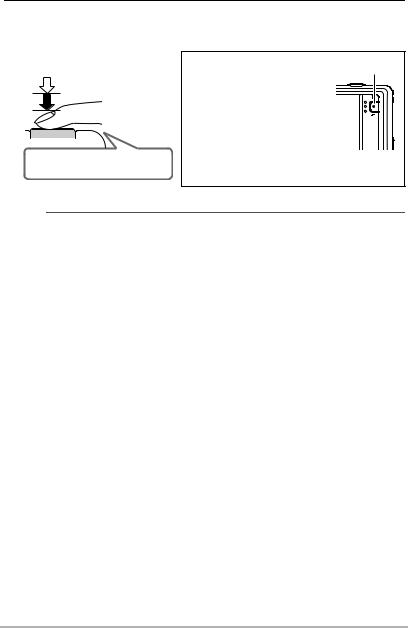
3.Continuing to keep the camera still, press the shutter button the rest of the way down.
This records the snapshot.
Full-press
Snap (Image is recorded.)
 NOTE
NOTE
Recording a Movie |
[0] (Movie) |
Press [0] (Movie) to start |
|
movie recording. Press |
|
[0] (Movie) again to stop |
|
movie recording. See |
|
page 37 for details. |
|
•You also can shoot a snapshot by touching a point on the monitor screen (page 42).
•You can specify the image size for snapshots. See page 45 for more information.
. If the image does not focus...
If the focus frame stays red and the back lamp is flashing green, it means that the image is not in focus (because the subject is too close, etc.). Re-point the camera at the subject and try to focus again.
. If the subject is not in the center of the frame...
“Focus lock” (page 44) is the name of a technique you can use when you want to shoot an image in which the subject to be focused on is not within the focus frame in the center of the screen.
28 |
Quick Start Basics |
|
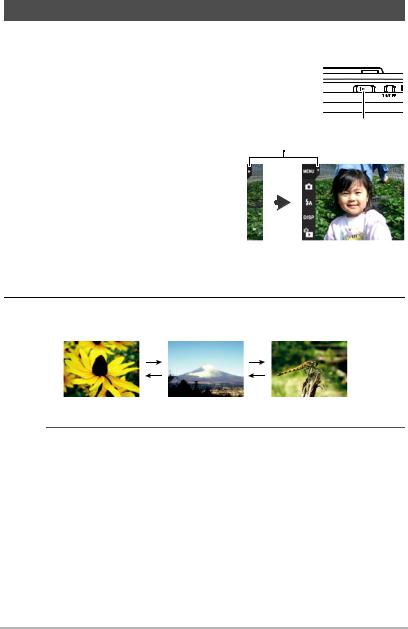
Viewing Snapshots
Use the following procedure to view snapshots on the camera’s monitor screen.
• For information about how to play back movies, see page 53.
1. Press [p] (PLAY) or touch “f”
(PLAY) to enter the PLAY mode.
This will display one of the snapshots
currently stored in memory. |
|
|
• |
If “f” (PLAY) is not displayed on the |
[p] (PLAY) |
|
screen, touch the tab to display it. |
|
|
|
|
• |
Information about the displayed |
Tab |
|
snapshot also is included (page 9). |
|
•You also can clear the information to view only the snapshot (page 10).
•You can zoom the screen image by
sliding the zoom controller towards z |
|
|
|
|
|
|
|
|
|
||
or by touching the monitor screen |
|
|
|
(page 55). |
|
|
|
If you are recording a snapshot that is |
|
|
|
|
|
||
very important to you, it is |
“f” (PLAY) |
||
recommended that you zoom the |
|
|
|
image and check its details after recording it. |
|
|
|
2.Drag left or right across the screen image to scroll through the snapshots.
 NOTE
NOTE
•Pressing the shutter button while in the PLAY mode or while a menu screen is displayed will switch directly to the REC mode.
29 |
Quick Start Basics |
|
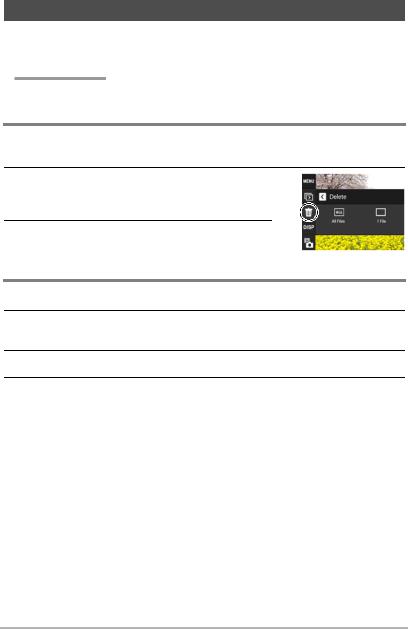
Deleting Snapshots and Movies
If memory becomes full, you can delete snapshots and movies you no longer need in order to free up storage and record more images.
 IMPORTANT!
IMPORTANT!
• Remember that a file (image) delete operation cannot be undone.

 To delete a single file
To delete a single file
1.In the PLAY mode, drag left or right across the screen image to scroll through files until you find the one you want to delete.
2.Touch “t”.
• If “t” is not displayed on the screen, touch the tab to display it.
3.Touch “1 File”.
This will delete the selected image.

 To delete all files
To delete all files
1.Enter the PLAY mode.
2.Touch “t”.
•If “t” is not displayed on the screen, touch the tab to display it.
3.Touch “All Files”.
4.Touch “Delete”.
This will cause the message “There are no files” to appear.
30 |
Quick Start Basics |
|
